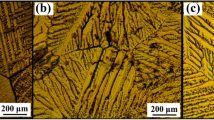Abstract
While the thick growth of intermediate phase layers generally benefits the corrosion resistance of galvanized steels, it is unfavorable from the standpoints of mechanical integrity and economics. Thus, the influence of nickel chloride-based fluxes and the typical zinc-ammonium chloride flux on galvanized coating thickness as well as coating morphology and composition is examined. The investigation of pretreated hot dip galvanized steel specimens for various durations has verified that nickel chloride fluxes influence the growth rate of the zeta interlayer. This results in the overall reduction of the coating thickness by as much as two times compared to those prepared with the conventional flux. Nickel from the fluxes gradually diffuses away from the substrate s surface, and hence the initial concentration of the nickel salts along with the hot dip duration needs to be controlled appropriately for effective use of nickel chloride-based fluxes in the galvanizing process.
Similar content being viewed by others
References
Marder A R. The Metallurgy of Zinc-Coated Steel [J]. Progress in Materials Science, 2000, 45(3): 191.
Syahbuddin, Munroe P R, Laksmi C S, et al. Effects of 0.1 and 0.2 wt% Aluminium Addition to Zinc on the Interdiffusion Between Zinc and Iron at 400 °C [J]. Materials Science and Engineering, 1998, 251A(1): 87.
Zapponi M, Quiroga A, Perez T. Segregation of Alloying Elements During the Hot-Dip Coating Solidification Process [J]. Surface and Coatings Technology, 1999, 122(1): 18.
Fratesi R, Ruffini N, Malavolta M, et al. Contemporary Use of Ni and Bi in Hot-Dip Galvanizing [J]. Surface and Coatings Technology, 2002, 157(1): 34.
Asgari H, Toroghinejad M R, Golozar M A. On Texture, Corrosion Resistance and Morphology of Hot-Dip Galvanized Zinc Coatings [J]. Applied Surface Science, 2007, 253(16): 6769.
Pistofidis N, Vourlias G, Konidaris S, et al. The Effect of Bismuth on the Structure of Zinc Hot-Dip Galvanized Coatings [J]. Materials Letter, 2007, 61(4/5): 994.
Lee H J, Kim J S. Effect of Ni Addition in Zinc Bath on Formation of Inhibition Layer During Galvannealing of Hot-Dip Galvanized Sheet Steels [J]. Journal of Materials Science Letters, 2001, 20(10): 955.
Notowidjojo B, Wingrove A L, Kennon N F. Zinc-0. 1% Nickel Coating of Silicon Steel [J]. Materials Forum, 1989, 13(2): 153.
Chen Z W, See J B. Dross Phases Formed in Galvanizing Baths Containing (0-0.1) wt% Nickel at 450 °C [J]. ISIJ International, 1993, 33(2): 307.
Pistofidis N, Vourlias G, Konidaris S, et al. The Effect of Preflux Bath Additives on the Morphology and Structure of the Hot-Dip Galvanized Coatings [J]. Crystal Research and Technology, 2006, 41(8): 759.
SU Xu-ping, TANG Nai-yong, Toguri J M. Thermodynamic Evaluation of the Fe-Zn System [J]. Journal of Alloys and Compounds, 2001, 325(1/2): 129.
Kainuma R, Ishida K. Reactive Diffusion Between Solid Fe and Liquid Zn at 723 K [J]. ISIJ International, 2007, 47(5): 740.
Ueda S, Taguchi O, Iijima Y, et al. Growth Kinetics of Intermediate Phase Layers in an Early Stage of Hot Dip Galvanizing at 450 °C [J]. Journal of Materials Science, 2008, 43(16): 5666.
Mackowiak J, Short N R. Metallurgy of Galvanized Coatings [J]. International Materials Review, 1979, 24(1): 1.
Dvorak P, Jandova J. Hydrometallurgical Recovery of Zinc From Hot Dip Galvanizing Ash [J]. Hydrometallurgy, 2005, 77(1): 29.
Dufresne A, Perrault G, Roy C, et al. Characterization of Ambient Air Contaminants From Hot-Dip Galvanizing Plants [J]. Annals of Occupational Hygiene, 1988, 32(2): 179.
Author information
Authors and Affiliations
Corresponding author
Additional information
Foundation Item: Item Sponsored by Iron and Steel Institute of Thailand (ISIT) for Research Funding (022/2552)
Rights and permissions
About this article
Cite this article
Boonyongmaneerat, Y., Saengkiettiyut, K., Rattanawaleedirojn, P. et al. Effect of NiCl2-Based Fluxes on Interfacial Layer Formation of Hot Dip Galvanized Steels. J. Iron Steel Res. Int. 17, 74–78 (2010). https://doi.org/10.1016/S1006-706X(10)60132-X
Revised:
Published:
Issue Date:
DOI: https://doi.org/10.1016/S1006-706X(10)60132-X




